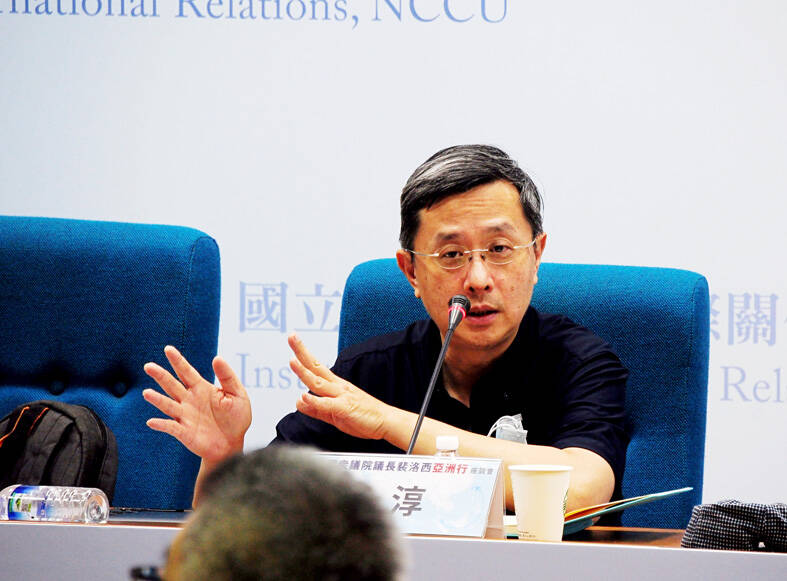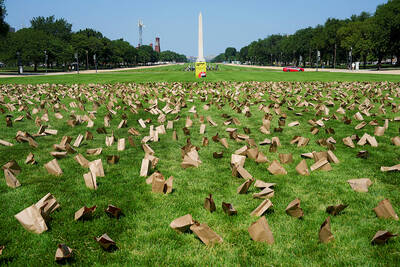A proposed US-led chip alliance is aimed not only at boosting production, but is also seen as a US move to counter China’s growing influence in the global chip market, Chung-Hua Institution for Economic Research economist Roy Lee (李淳) said on Sunday.
The Chip 4 alliance is a proposed alliance of semiconductor powerhouses in the US, Taiwan, Japan and South Korea, to enhance cooperation on the design and production of sophisticated semiconductors.
With a preliminary meeting of the alliance reportedly expected to take place at the end of this month or early next month, the Ministry of Economic Affairs has proposed continuing its collaboration with the US on supply chain resilience and industrial cooperation, as well as semiconductor supply security.

Photo: CNA
Lee, deputy executive director of the Taiwan WTO & RTA Center at the institute, said that the ministry’s proposal to cooperate on supply chain security was made with Taiwan’s needs in mind.
Although Taiwan is strong in semiconductor foundries, it relies on the US and Japan for the supply of equipment and materials, he said, adding that there are areas where the three nations are reliant on each other.
If the US aims only to bring semiconductor production back home, it only needs to negotiate with individual nations, Lee said.
As such, it is believed that the US might want to work with Taiwan, Japan and South Korea to impose controls on semiconductor exports and technology outflows, forming an anti-China group to exclude Beijing from global semiconductor supply chains, he said.
However, the US proposal might put a certain amount of pressure on South Korea due to its economic ties with China, its biggest trade partner, so Washington wants to talk to Seoul to see whether it plans to join Chip 4, Lee said.
China, including Hong Kong, accounts for almost 60 percent of the exports of South Korean chips, according to a report in the Korea Herald, South Korea’s largest English-language daily, which presents a dilemma for Seoul in having to choose between US technology and the Chinese market, he said.
On the pros and cons of Taiwan’s participation in the alliance, Lee said that Taiwan should participate, given the close semiconductor links between Taiwan and the US, especially regarding supply chains and intelligence gathering.
The US Congress last month passed the CHIPS Act of 2022 to strengthen domestic semiconductor manufacturing, design and research.
In addition, Washington has been promoting the Chip 4 alliance and announced a ban on exports of advanced electronic design automation software tools for 3-nanometer and other advanced chips to China in an effort to curb the development of China’s chip industry.

Nvidia Corp chief executive officer Jensen Huang (黃仁勳) on Monday introduced the company’s latest supercomputer platform, featuring six new chips made by Taiwan Semiconductor Manufacturing Co (TSMC, 台積電), saying that it is now “in full production.” “If Vera Rubin is going to be in time for this year, it must be in production by now, and so, today I can tell you that Vera Rubin is in full production,” Huang said during his keynote speech at CES in Las Vegas. The rollout of six concurrent chips for Vera Rubin — the company’s next-generation artificial intelligence (AI) computing platform — marks a strategic

Enhanced tax credits that have helped reduce the cost of health insurance for the vast majority of US Affordable Care Act enrollees expired on Jan.1, cementing higher health costs for millions of Americans at the start of the new year. Democrats forced a 43-day US government shutdown over the issue. Moderate Republicans called for a solution to save their political aspirations this year. US President Donald Trump floated a way out, only to back off after conservative backlash. In the end, no one’s efforts were enough to save the subsidies before their expiration date. A US House of Representatives vote

REVENUE PERFORMANCE: Cloud and network products, and electronic components saw strong increases, while smart consumer electronics and computing products fell Hon Hai Precision Industry Co (鴻海精密) yesterday posted 26.51 percent quarterly growth in revenue for last quarter to NT$2.6 trillion (US$82.44 billion), the strongest on record for the period and above expectations, but the company forecast a slight revenue dip this quarter due to seasonal factors. On an annual basis, revenue last quarter grew 22.07 percent, the company said. Analysts on average estimated about NT$2.4 trillion increase. Hon Hai, which assembles servers for Nvidia Corp and iPhones for Apple Inc, is expanding its capacity in the US, adding artificial intelligence (AI) server production in Wisconsin and Texas, where it operates established campuses. This

US President Donald Trump on Friday blocked US photonics firm HieFo Corp’s US$3 million acquisition of assets in New Jersey-based aerospace and defense specialist Emcore Corp, citing national security and China-related concerns. In an order released by the White House, Trump said HieFo was “controlled by a citizen of the People’s Republic of China” and that its 2024 acquisition of Emcore’s businesses led the US president to believe that it might “take action that threatens to impair the national security of the United States.” The order did not name the person or detail Trump’s concerns. “The Transaction is hereby prohibited,”